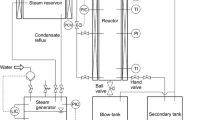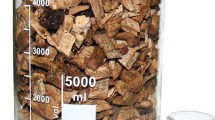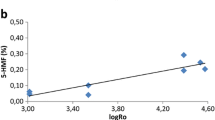Abstract
A combination of Douglas fir heartwood and sapwood chips were steam pretreated under three conditions as measured by the Severity Factor (log Ro), which incorporated the time, temperature/pressure of pretreatment. By adjusting the steam pretreatment conditions, it was hoped to recover the majority of the hemicellulose component as monomers in the water-soluble stream, while providing a cellulosic-rich, water-insoluble fraction that could be readily hydrolyzed by cellulases. These three conditions were chosen to represent either high hemicellulose sugar recovery (low severity [L], log Ro=3.08), high-enzyme hydrolyzability of the cellulosic component (high severity [H], log Ro=4.21), and a compromise between the two conditions (medium severity [M], log Ro=3.45). The medium-severity pretreatment conditions (195°C, 4.5 min, 4.5% SO2 logRo=3.45) gave the best compromise in terms of relatively high hemicellulose recovery after stream pretreatment and the subsequent efficiency of enzymatic hydrolysis of the water-insoluble cellulosic fraction. The percent recovery of the original hemicellulose in the water-soluble fraction dropped significantly when the severity was increased (L-76.8%, M-64.7%, and H-37.5%). However, the ease of enzymatic hydrolysis of the cellulose-rich, water-insoluble fraction increased with increasing severity (L-24%, M-86.6%, and H-97.9%). Although more severe pretreatment conditions provided optimum hydrolysis of the cellulosic component, less severe conditions resulted in better recovery of the combined hemicellulose and cellulosic components.
Similar content being viewed by others
References
Ministry of Environment, Lands and Parks, Government of British Columbia, (1997), “Wood Residue Opportunities Strategy,” prepared by G. E. Bridges & Associated Inc., Victoria, British Columbia, Canada.
Saddler, J. N. (1992), Biomass Bioenergy 2 (1–6), 229–238.
Schwald, W., Smaridge, T., Chan, M., Breuil, C., and Saddler, J. N. (1989) in Enzyme Systems For Lignocellulose Degradation, Coughlan, M. P., ed., Elsevier, New York, pp. 231–242.
Heitz, M., Capek-Menard, E., Koeberle, P. G., Gagne, J., Chornet, E., Overend, R. P., Taylor J. D., and Yu, E. (1991), Bioresource Technol. 35, 23–32.
Olsson, L. and Hahn-Hagerdal, B. (1995), Enzyme Micro. Technol. 18, 1–17.
Gregg, D. J. and Saddler, J. N. (1996), Applied Biochem. Biotech. 57/58, 711–727.
Nguyen, Q. A. and Saddler, J. N. (1991), Biores. Technol. 85, 275–282.
Boussaid, A., Jarvis, J., Gregg, D. J., and Saddler, J. N. (1997), Optimization of Hemicellulose Sugar Recovery from a Steam-Exploded Softwood (Douglas Fir), Overend, R. P. and Chornet, E., eds., The Third Biomass Conference of the Americas, Montreal, Quebec, Canada, pp. 873–880.
Saddler, J. N., Ramos, L. P., and Breuil, C. (1993), in Bioconversion of Forest and Agriculture Residues, Saddler, J. N., ed., Cab International, Oxford, UK, pp. 73–92.
Overend, R. P. and Chornet, E. (1987), Phil. Trans. R. S. Lond. A321, 523–536.
Wood, T. M. and Bhat, K. M. (1988), in Methods In Enzymology vol. 160, Wood, W. A. and Kellogg, S. T., eds., Academic, 87–111.
Breuil, C., Chan, M., Gilbert, M., and Saddler, J. N. (1992), Biores. Technol. 39, 139–142.
Sjostrom, E. (1993), Wood Chemistry: Fundamentals and Applications, Academic, London.
Author information
Authors and Affiliations
Rights and permissions
About this article
Cite this article
Wu, M.M., Chang, K., Gregg, D.J. et al. Optimization of steam explosion to enhance hemicellulose recovery and enzymatic hydrolysis of cellulose in softwoods. Appl Biochem Biotechnol 77, 47–54 (1999). https://doi.org/10.1385/ABAB:77:1-3:47
Issue Date:
DOI: https://doi.org/10.1385/ABAB:77:1-3:47




